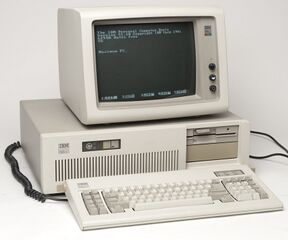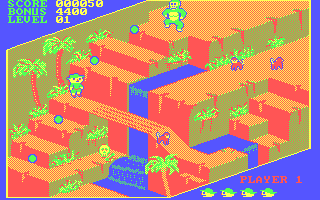IBM PC
From Sega Retro

|
| IBM PC |
|---|
| Manufacturer: IBM |
The IBM PC is a range of computers released by IBM over the course of the 1980s. Aimed primarily at business users, the original IBM PC 5150 was an expensive but robust machine designed for text input, however its use of off-the-shelf parts and modular design allowed the system to be tailored to a wide variety of needs, including video games.
The IBM PC is one of the most significant computers ever released, as while the design was easily replicated (to the point where IBM had stopped being the biggest supplier of so-called IBM PC compatibles by the mid-1980s), its successes in the business (and later home markets) coupled with the Microsoft operating systems MS-DOS and later Windows, mean it is the ancestor of the vast majority of computers in use today.
Sega Retro classes all "PC" games released for DOS (or as self-boot floppy disks) as "IBM PC" games. Those which require Microsoft Windows to run (i.e. most software after 1995) are classed as "Windows PC" games.
Contents
Sega support
For the first few years of its life, the IBM PC was not considered a gaming machine, nor even a product suited for the home. In 1981, graphics cards for the IBM PC were optional, as were colour monitors, and while software was produced to take advantage of both, the PC was not seen as a viable platform for games until at least 1983.
An initial wave of Sega-related PC titles arrived in late 1983 as self-boot floppy disks (that is to say, when placed in the A: drive when the computer is turned on, the game will instantly load without the need for an MS-DOS boot disk). These were designed to take advantage of the only graphics card available for the system at the time - the "color graphics adapter" (CGA) board. Later titles, designed to be booted from MS-DOS, would use the expanded EGA and VGA graphics standards from 1984 and 1987, respectively. Likewise, games initially only made use of the internal one-channel PC speaker, though support for Adlib and SoundBlaster cards (among other standards) would appear after 1987 and 1990, respectively.
The initially high cost of maintaining an IBM PC (in comparison to something more suited for home use such as a Commodore 64) meant that uptake of these new standards was slow, and so backwards compatibility with older cards was often made available in games. However, while the PC became more capable in each passing year, PC games released during the 1980s were generally less advanced than their counterparts on the Amiga and Atari ST. It was not until the release of Intel 486 CPUs and groundbreaking products such as Doom where PC compatibles were considered truly competitive in the gaming market.
Sega did not support the IBM PC directly, instead going through third-party publishers as was the case with other home computers (save for the SC-3000). In the late 1980s, the primary market for IBM PC games was the United States, and so most PC development work occurred stateside. However, many titles were conversions of European-led Amiga and Atari ST ports. Mindscape distributed most Sega PC conversions during this era. With European home computers having priority and IBM versions being produced afterwards, fewer IBM PC ports were made in total, and almost all of them were released after their counterparts in Europe.
List of Sega games for the IBM PC
- Frogger (1983)
- Zaxxon (1983)
- Buck Rogers: Planet of Zoom (1984)
- Congo Bongo (1984)
- Frogger II: Threeedeep! (1984)
- Spy Hunter (1984)
- Super Zaxxon (1984)
- Up'n Down (1987)
- Super Hang-On (1989)
- Action Fighter (1989)
- After Burner (1989)
- Alien Syndrome (1989)
- OutRun (1989)
- Power Drift (1989)
- Shinobi (1989)
- Space Harrier (1989)
- Thunder Blade (1989)
- Altered Beast (1990)
- Crack Down (1990)
- Joe Montana Football (1990)
- Golden Axe (1990)
- Turbo OutRun (1990)
- World Championship Soccer (1990)
- Super Monaco GP (1991)
Compilations
Other IBM PC games also released for Sega systems
- 3D Lemmings
- 688 Attack Sub
- Ace of Aces
- Alien Trilogy
- Alone in the Dark 2
- American Gladiators
- AMOK
- Another World
- Assault Rigs
- Atlantis: The Lost Tales
- Back to the Future Part II
- Back to the Future Part III
- Baldy Land
- Barbie Super Model
- Batman Forever
- Batman Forever
- Battlemaster
- BattleSport
- BC Racers
- Best of the Best: Championship Karate
- Bible Adventures
- Blackthorne
- Blam! Machinehead
- Blast Chamber
- Blockout
- Brain Dead 13
- Brutal: Paws of Fury
- Bubble Bobble
- Bubble Bobble also featuring Rainbow Islands
- Budokan: The Martial Spirit
- Bust-A-Move 2: Arcade Edition
- Cadillacs and Dinosaurs: The Second Cataclysm
- California Games
- California Games II
- Cannon Fodder
- Centurion: Defender of Rome
- Championship Lode Runner
- Chaos Control
- Civilization: Shin Sekai Shichi Dai Bunmei
- College Slam
- Command & Conquer
- Cool Spot
- Corporation
- Cosmic Spacehead
- Creature Shock: Special Edition
- Crime Patrol
- Crusader: No Remorse
- CyberBall
- Cyberia
- D
- Daikoukai Jidai II
- Dark Castle
- Dark Seed
- Darklight Conflict
- Death Throttle: Kakuzetsu Toshi kara no Dasshutsu
- DeathMask
- Defcon 5
- Desert Strike: Return to the Gulf
- Destruction Derby
- Dig Dug
- Discworld
- Discworld II: Missing Presumed...!?
- Disney's Aladdin
- Doom
- Double Dragon
- Double Dragon 3: The Rosetta Stone
- Double Dragon II: The Revenge
- Dracula Unleashed
- Dragon Slayer: The Legend of Heroes
- Dragon Slayer: The Legend of Heroes II
- Dragon's Lair
- Druid: Yami-He no Tsuiseki Sha
- Duke Nukem 3D
- Dune
- Dungeon Master II: Skullkeep
- Earthworm Jim
- Earthworm Jim 2
- ESPN Baseball Tonight
- Exodus: Journey to the Promised Land
- Eye of the Beholder
- F-15 Strike Eagle
- F-15 Strike Eagle II
- F1
- Fantastic Dizzy
- FIFA International Soccer
- FIFA Soccer 96
- FIFA Soccer 97
- Fire & Forget II
- Fire & Ice
- Flashback
- Forgotten Worlds
- Frank Thomas Big Hurt Baseball
- Gauntlet
- Gear Works
- Gemfire
- Genghis Khan II: Clan of the Gray Wolf
- Ghostbusters
- Gods
- Gunship
- Hard Drivin'
- HardBall!
- Heimdall
- Heroes of the Lance
- Hexen
- Hi-Octane
- Hyper 3D Pinball
- Indiana Jones and the Last Crusade
- Ishido: The Way of Stones
- Jammit
- Jimmy White's Whirlwind Snooker
- Joe & Mac
- Johnny Bazookatone
- Jonah Lomu Rugby
- Jordan vs Bird
- Joshua & The Battle of Jericho
- Judge Dredd
- Jungle Strike
- Kick Off 3: European Challenge
- Kids on Site
- King's Bounty: The Conqueror's Quest
- King's Quest: Quest for the Crown
- Klax
- Krusty's Fun House
- Kuro no Danshou: The Literary Fragment
- Lemmings
- Lemmings 2: The Tribes
- LHX Attack Chopper
- Links: The Challenge of Golf
- Lode Runner
- Lode Runner: The Legend Returns
- Lotus II: RECS
- M-1 Abrams Battle Tank
- Mad Dog II: The Lost Gold
- Mad Dog McCree
- Magic Carpet
- Magic Pockets
- Mass Destruction
- Math Blaster: Episode 1
- MechWarrior 2: 31st Century Combat
- MegaRace
- Micro Machines
- Micro Machines 2: Turbo Tournament
- Microcosm
- Might and Magic III: Isles of Terra
- Might and Magic: Gates to Another World
- Mike Ditka Power Football
- Montezuma's Revenge
- Mortal Kombat
- Mortal Kombat 3
- Mortal Kombat Trilogy
- Ms. Pac-Man
- NBA Jam Tournament Edition
- NBA Live 96
- NBA Live 97
- NFL Quarterback Club '96
- NFL Quarterback Club '97
- NHL 95
- NHL 96
- NHL 97
- Nigel Mansell's World Championship Racing
- Night Trap
- Nobunaga no Yabou Sengoku Gunyuuden
- Nobunaga's Ambition
- Novastorm
- Olympic Soccer
- Onslaught
- Operation Europe: Path to Victory 1939-45
- Operation Wolf
- Pac-Man
- Paperboy
- Paperboy 2
- PGA European Tour
- PGA Tour 96
- Phantasm
- Pinball Dreams
- Pirates! Gold
- Pit-Fighter
- Pitfall II: The Lost Caverns
- Power Drive
- Premier Manager
- Primal Rage
- Princess Maker 2
- Prisoner of Ice: Jashin Kourin
- Pro-Pinball: The Web
- Psycho Pinball
- Puyo Puyo Tsuu
- Puznic
- Q*bert
- Quake
- Quarterback Attack with Mike Ditka
- Rampage
- Rampart
- Rastan
- Rayman
- Renegade
- Return to Zork
- Revolution X
- Rise 2 Resurrection
- Rise of the Dragon
- Rise of the Robots
- Risky Woods
- Road & Track Presents The Need for Speed
- Romance of the Three Kingdoms II
- Romance of the Three Kingdoms III: Dragon of Destiny
- Rugby World Cup 1995
- S.S. Lucifer: Man Overboard!
- Sangokushi IV
- Sangokushi V
- Scorcher
- Senken Kigyouden
- Shanghai
- Shanghai II: Dragon's Eye
- Shellshock
- Sherlock Holmes: Consulting Detective Vol. I
- Sherlock Holmes: Consulting Detective Vol. II
- SimCity 2000
- SimEarth
- Slam 'n Jam '96 Featuring Magic & Kareem
- Slam City with Scottie Pippen
- Slaughter Sport
- Slider
- Solomon no Kagi: Oujo Rihita no Namida
- Sorcerian
- Space Ace
- Space Jam
- Speedball
- Spiritual Warfare
- Spirou
- Star Control
- Star Wars: Rebel Assault
- StarFighter 3000
- Starflight
- Stormlord
- Street Racer
- Striker
- Striker '96
- Suikoden: Tenmei no Chikai
- Summer Challenge
- Super Off Road
- Super Space Invaders
- Super Street Fighter II: The New Challengers
- Supreme Warrior
- T-MEK
- T2: The Arcade Game
- Technocop
- Tempest 2000
- Tesserae
- The Adventures of Willy Beamish
- The Chaos Engine
- The Duel: Test Drive II
- The Faery Tale Adventure
- The Horde
- The Humans
- The Incredible Hulk: The Pantheon Saga
- The Jungle Book
- The Lawnmower Man
- The Lion King
- The Lost Vikings
- The Lost Vikings 2: Norse by Norsewest
- The Manhole
- The Secret of Monkey Island
- The Simpsons: Bart vs. the Space Mutants
- The Smurfs
- The Software Toolworks' Star Wars Chess
- Theme Park
- Thunderhawk
- Thunderhawk II
- Tintin in Tibet
- Tomb Raider
- Trash It
- Tunnel B1
- Two Tribes: Populous II
- UEFA Euro 96 England
- Ultima IV: Quest of the Avatar
- Ultimate Qix
- Uncharted Waters
- Unnecessary Roughness '95
- Virtual Golf
- VR Soccer
- Wayne Gretzky and the NHLPA All-Stars
- Where in the World is Carmen Sandiego?
- Where in Time is Carmen Sandiego?
- Whizz
- Who Shot Johnny Rock?
- Will Harvey Presents The Immortal
- Wing Commander
- Winter Challenge
- Winter Olympics
- Wipeout
- Wizardry Nemesis
- World Class Leader Board
- World Cup USA 94
- World Games
- Worms
- WWF In Your House
- WWF WrestleMania: The Arcade Game
- Xenon 2: Megablast
- Ys: Ancient Ys Vanished Omen
- Yumimi Mix Remix
- Z
- Zany Golf
- Zool
- Zoom!
- Zoop
References
NEC Retro has more information related to IBM PC
|

